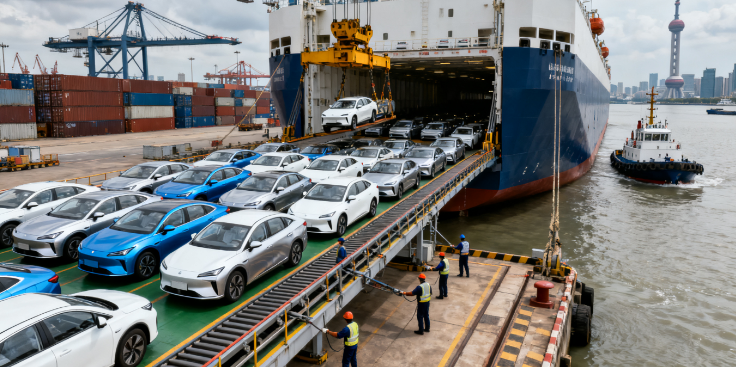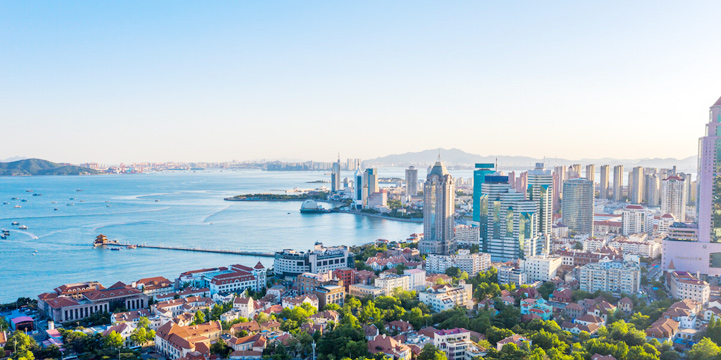
In Shanghai Port, Chinese domestically produced automobiles are exported using the "River-Sea Intermodal Transport" method. Initially, they travel downstream on the Yangtze River aboard river barges and upon reaching the Shanghai Port area, they transfer to ocean-bound roll-on/roll-off (Ro-Ro) ships for overseas voyages.
Shanghai Waigaoqiao Port's Haitong Terminal is China's largest single-vehicle Ro-Ro terminal, bustling with scenes of automotive transport: Ro-Ro ships from the upper reaches of the Yangtze River dock at the berths, automobiles orderly drive out waiting to board oceangoing Ro-Ro ships. Simultaneously, Ro-Ro ships filled with imported vehicles await unloading.
Operating 24 hours a day, the Haitong Terminal supports car exports and welcomes imported vehicles. The yard can accommodate 40,000 vehicles, with various types of cars awaiting loading onto Ro-Ro ships for export; while outside the area, flatbed trucks filled with cars continuously enter. Waigaoqiao Port has become the largest port for the import and export of automobiles in Shanghai.
According to data from the China Association of Automobile Manufacturers, in the first eight months of this year, China exported 4.29 million vehicles, a 13.7% increase. Of these, exports of new energy vehicles reached 1.532 million vehicles, an 87.3% increase.
The Haitong Terminal has 15 international automotive Ro-Ro routes, connecting to 289 ports in 131 countries and regions, with around 100 vessel calls per month, providing convenient whole-vehicle import and export water transportation services for car manufacturers. In 2024, Haitong Company handled a total throughput of 3.63 million vehicles for the year, topping the world rankings for the first time.
In the first eight months of this year, the Haitong Terminal at Waigaoqiao Port exported 962,700 vehicles, a 19.35% increase. Among these, 339,000 vehicles, accounting for 35.2% of the total exports, were exported using the "River-Sea Intermodal Transport" method.
The "River-Sea Intermodal Transport" mode integrates the ports along the Yangtze River with Shanghai's Waigaoqiao Port, promoting the integrated development of the Yangtze River Economic Belt and further optimizing Shanghai's status as an international shipping center.
To support the explosive growth of car exports at the Haitong Terminal, the Shanghai Waigaoqiao Port Customs actively plays the role of "Customs-Business Liaison Officer." Through an online business coordination mechanism, they obtain the docking plans of export Ro-Ro ships in advance, ensuring seamless coordination from vehicle entry, stacking, inspection, vehicle movement, and clearance processes at the terminal, and establish a car clearance appointment and emergency response mechanism, continuously optimizing customs supervision processes and procedures.
In the Yangshan Special Comprehensive Bonded Zone, the implementation of the "One-Box System" policy resolves the issue of inconsistent regulatory requirements between rail and maritime transport for new energy vehicles, which previously led to container changes at rail stations. Additionally, a pre-clearance warehouse for vehicle exports has been established in the area to efficiently complete vehicle strapping, transitioning from "ship waiting for cars" to "car waiting for ships."
The Lingang New Area has launched the "Digital Comprehensive Bonded Zone" platform, aiding in solving issues related to batch customs clearance and verification for automobiles, enabling companies to respond more rapidly to market order demands. Under the impetus of these innovative measures, Shanghai's Nangang realized the import of 38,573 foreign trade vehicles from January to July of this year, an 18% increase, and exported 315,640 foreign trade vehicles, a 30% increase year-on-year.
The export boom in Chinese automobiles has also driven the prosperity of the shipbuilding industry. Near the Waigaoqiao Haitong Terminal at the Outer Port, China Shipbuilding Waigaoqiao Shipbuilding has successively delivered two Ro-Ro ships with a capacity of 9,000 vehicles in just over a month, continuously setting records for construction cycles.
Wei Yan from the Marketing Department of China Shipbuilding Waigaoqiao Shipbuilding Market stated that the shipbuilding structure at Waigaoqiao Shipbuilding has evolved from a focus on bulk carriers and oil tankers to now covering high-value-added vessel types such as large cruise ships, medium and large oil tankers, medium and large container ships, and car carriers. Currently, they have delivered 602 vessels, with delivery dates scheduled up to 2029. Waigaoqiao Shipbuilding has undertaken orders for 16 PCTCs, with shipowners not only from Chinese shipping companies but also from South Korea and Italy.
